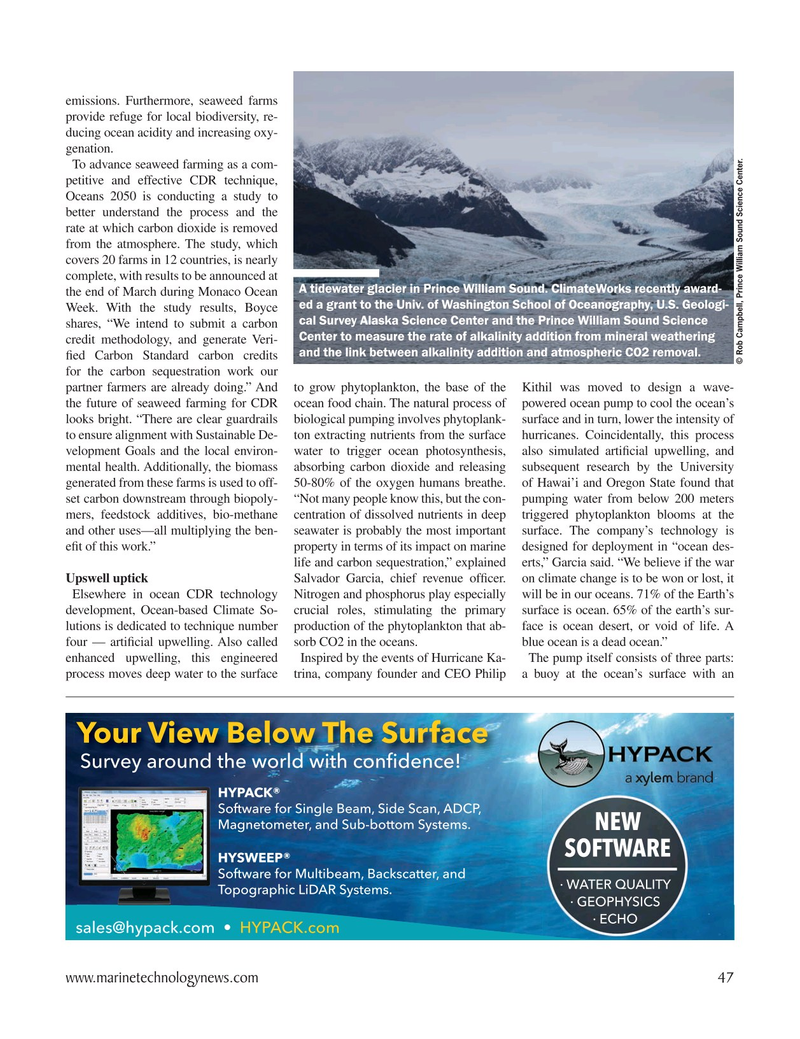
Page 47: of Marine Technology Magazine (March 2022)
Read this page in Pdf, Flash or Html5 edition of March 2022 Marine Technology Magazine
emissions. Furthermore, seaweed farms provide refuge for local biodiversity, re- ducing ocean acidity and increasing oxy- genation.
To advance seaweed farming as a com- petitive and effective CDR technique,
Oceans 2050 is conducting a study to better understand the process and the rate at which carbon dioxide is removed from the atmosphere. The study, which covers 20 farms in 12 countries, is nearly complete, with results to be announced at
A tidewater glacier in Prince William Sound. ClimateWorks recently award- the end of March during Monaco Ocean ed a grant to the Univ. of Washington School of Oceanography, U.S. Geologi-
Week. With the study results, Boyce cal Survey Alaska Science Center and the Prince William Sound Science shares, “We intend to submit a carbon
Center to measure the rate of alkalinity addition from mineral weathering credit methodology, and generate Veri- ? ed Carbon Standard carbon credits and the link between alkalinity addition and atmospheric CO2 removal. © Rob Campbell, Prince William Sound Science Center.
for the carbon sequestration work our partner farmers are already doing.” And to grow phytoplankton, the base of the Kithil was moved to design a wave- the future of seaweed farming for CDR ocean food chain. The natural process of powered ocean pump to cool the ocean’s looks bright. “There are clear guardrails biological pumping involves phytoplank- surface and in turn, lower the intensity of to ensure alignment with Sustainable De- ton extracting nutrients from the surface hurricanes. Coincidentally, this process velopment Goals and the local environ- water to trigger ocean photosynthesis, also simulated arti? cial upwelling, and mental health. Additionally, the biomass absorbing carbon dioxide and releasing subsequent research by the University generated from these farms is used to off- 50-80% of the oxygen humans breathe. of Hawai’i and Oregon State found that set carbon downstream through biopoly- “Not many people know this, but the con- pumping water from below 200 meters mers, feedstock additives, bio-methane centration of dissolved nutrients in deep triggered phytoplankton blooms at the and other uses—all multiplying the ben- seawater is probably the most important surface. The company’s technology is e? t of this work.” property in terms of its impact on marine designed for deployment in “ocean des- life and carbon sequestration,” explained erts,” Garcia said. “We believe if the war
Upswell uptick Salvador Garcia, chief revenue of? cer. on climate change is to be won or lost, it
Elsewhere in ocean CDR technology Nitrogen and phosphorus play especially will be in our oceans. 71% of the Earth’s development, Ocean-based Climate So- crucial roles, stimulating the primary surface is ocean. 65% of the earth’s sur- lutions is dedicated to technique number production of the phytoplankton that ab- face is ocean desert, or void of life. A four — arti? cial upwelling. Also called sorb CO2 in the oceans. blue ocean is a dead ocean.” enhanced upwelling, this engineered Inspired by the events of Hurricane Ka- The pump itself consists of three parts: process moves deep water to the surface trina, company founder and CEO Philip a buoy at the ocean’s surface with an
Your View Below The Surface
Survey around the world with con?dence!S d h ld i h ?d !
HYPACK®
Software for Single Beam, Side Scan, ADCP,
Magnetometer, and Sub-bottom Systems.
NEW
SOFTWARE
HYSWEEP®
Software for Multibeam, Backscatter, and · WATER QUALITY
Topographic LiDAR Systems.
· GEOPHYSICS · ECHO [email protected] • HYPACK.com www.marinetechnologynews.com 47
MTR #3 (34-49).indd 47 2/25/2022 10:16:08 AM

 46
46

 48
48
